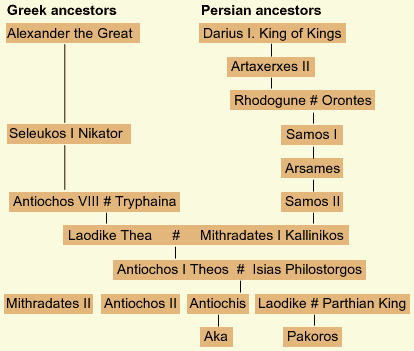Antiochos the son of king Mithridates and queen Laodike, received an education from his parents which was a mixture of Greek and Persian. On his mother’s side, queen Laodike, he descended from Alexander the Great. While on his father’s side, he descended from the Persian ‘King of Kings’, Darius I.
His father arranged a marriage for him with a Seleucid princess named Isias Philostorgos, ‘The Beloved One’. Such a marriage had little to do with love, its purpose was purely political.
Antiochos built all over the country small sanctuaries, called temene. The temene were built on top of striking points in the landscape. From there you could always see to the most important of them all, the sanctuary on top of holy Mount Nemrud. These sanctuaries consisted of stone slabs, depicting the king shaking hands with one of the gods. You can find these reliefs in the deep valleys of Kommagene as well as on top of Mt.Nemrud.
All gods have a Greek and a Persian name i.e. Apollo/Mithras, Herakles/Artagnes and Zeus/Oromasdes. The Greek and Persian names of the gods meant that each Kommagenian, whether he had Greek or Persian ancestors, felt close to them.
By establishing a treaty with the gods, there grew the feeling amongst his subjects that they were a chosen people, favoured by the gods and under their protection. As a consequence of this, Antiochos could forge a bond between the different population groups in his kingdom.
The 10th of Loos, a day in July, was the day of the “Manifestation of the Great Gods”. It was also the day commemorating the coronation of the king. Each year, on that particular day, all the citizens of Kommagene assembled at the small sanctuaries within reach of their village or town, to celebrate this occasion. For the people of Kommagene this was the annual confirmation of their bond with the gods under whose protection they lived.
For his father, Antiochos felt a deep respect, but his mother Laodike, he loved above all. He mentioned her specifically in various inscriptions, calling himself ‘He who loves his mother’. He bestowed upon her the honorary name Thea (Goddess). Together with his mother he immortalised them both between the statues of the gods on Mount Nemrud. She, sitting at the right hand of Zeus, as the goddess of Kommagene, Thea. He, sitting next to her, as the king of Kommagene, Theos.
Genealogical Tree of King Antiochos I Theos




